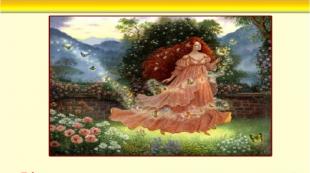Creative project "Plant in the interior of a residential building." Presentation "Plant in the interior of a residential building" on technologies - project, report Presentation of plant technology in the interior of a residential building
HOUSE PLANTS IN THE INTERIOR
technology teacher
MBOU secondary school No. 1 Korolev M. o.
Monina Anna Alexandrovna

Lesson Objectives
- Educational - to acquaint students with the role of indoor plants in human life; study the technology, the rules of care various types indoor plants and their placement in the room, depending on the type.
- Educational - instill a desire for beauty and comfort in the design of the surrounding interior.
- Educational - develop aesthetic taste, broaden horizons.
- Career guidance - acquaintance with the profession of a phytodesigner.

The role of indoor plants in the interior.
It is difficult to imagine a house without flowers in our time. Advice from videoecologists: people in the room where they are on duty should definitely start
indoor flowers, because they improve mood, purify and humidify the air, and also destroy harmful microorganisms.

Rules for the care of indoor plants.
Success in landscaping depends on right choice plants that correspond in their natural properties to room conditions.

Conditions of detention.
- tropical plants (Tradescantia, ferns) - require a lot of heat.
- Subtropical (geranium, Chinese rose) - require a lot of moisture.
- shade-tolerant (monstera, begonias) - tolerate low light.
- Light-loving (aloe, lemon, asparagus) - demanding on light.
- Fresh air A well ventilated area is helpful for most plants.

care conditions.
- For further normal growth and development of plants, care is required, which includes: choosing the appropriate soil, watering, cleaning, top dressing, transplanting or transshipment.

FLOWER POTS .
Indoor plants are grown in pots, in which the top is wider than the bottom or in wide bowls. This form makes it easy to knock out plants from dishes during transplantation. New pots are well soaked before planting in them, and the old ones are thoroughly washed in hot water and dry on fire.

soil mixtures.
- Each plant needs to choose the appropriate soil mix , consisting of sheet (peat and humus) and sod land, sand. Different plants require different types of soil.

Watering.
- Its frequency and amount of water depends on the type of plant, the phase of development and the time of year. It is recommended to water with water with a temperature of 2-3 degrees above the ambient temperature.

watering groups.
- Abundant watering (begonias, ficuses, ivy, lemon) - water as soon as the topsoil dries.
- moderate watering (chlorophytum, palm trees, asparagus) - water 1-2 days after the topsoil dries.
- Rare watering (cacti, aloe, gloxinia, hippeastrum) - can be left without watering for weeks and even months.
Most plants are watered abundantly in summer and moderately in winter.
In the spring - summer period, the plants must be sprayed (but not in the sun).

Cleaning.
- To improve photosynthesis, prevent diseases and damage to plants by pests, regular cleaning, i.e. washing the leaves, helps. Plants with pubescent leaves are cleaned of dust with a soft brush.

Top dressing.
- Plants need extra food to live. top dressing . It consists of nitrogen, potash and phosphorus fertilizers, which are not enough in the soil. Plants are fed during growth (spring and summer), after watering them with water.

Transfer.
As the plant grows and its root system increases, it is necessary transfer(replacement of the soil without preserving the coma). Pots are chosen 2-3 cm more than the previous ones. Plants are transplanted from late February to May.

Transshipment.
For plants that do not tolerate transplanting, apply transshipment, i.e. the plant is transferred to a new, large dish while maintaining a coma. A lump with a plant is placed on a new drainage layer and the empty spaces between the wall of the pot and the lump are filled with soil, the earth is compacted. You can transfer the plant at any time of the year.

Seeds.
cuttings.
The earth should be of medium humidity, and the temperature should not be lower than 25 degrees.

The technology of growing indoor plants.
The division of the bush.
The division of tubers.
The divided parts are planted in pots of appropriate sizes.
The tubers are divided so that each part has an eye.

The technology of growing indoor plants.
Bulbs.
Vaccinations.
Bulbs are separated in the spring after flowering and planted in pots in light soil.
Splicing a scion with a stock. It is used to preserve the varietal characteristics of the propagated plant.

Hydroponics .
- Growing plants on artificial nutrient media, in which all the necessary nutrients are given in an easily digestible form, in the right ratios and concentrations. Plants with this method of growing are placed in hydropots.

The technology of growing flowers without soil.
- substrates- inert earth substitutes: gravel, vermiculite, perlite, expanded clay, coarse sand, moss, peat. They are easy to disinfect, do not enter into chemical reactions with mineral salts dissolved in water, and provide good air access to the roots.

The technology of growing flowers without soil.
- The root neck of plants is fixed with clamps on the lid of the box, which is filled with a nutrient solution so that 1/3 of the roots are in the solution, and 2/3 in the airy, moist space between the poured solution and the lid of the box.
Aeroponics - non-substrate method of growing plants (air culture).


formed from the ancient Greek phyton - "plant" and English desiqn - "plan, design". Thus, phytodesign is the design and decoration of a person's living space using living plants.
Word phytodesign -

For every style and for every room, there are different types of plants that are designed to regulate humidity, oxygen levels, absorb dust and harmful substances.
Proper selection of plants is the key to success, because well-thought-out phytodesign in any room will benefit all its inhabitants.

Placement of indoor plants in the interior.
- Before you start working on a composition, you need to determine where it will be located. It is necessary to take into account the plant community of plants and their physiological characteristics. Plants must be properly matched for size, appearance, shape and growth rate, structure, and grouping capability.
- In addition to the basic placement techniques (single, compositions from potted plants, indoor garden and terrarium), there is a wide variety of combined compositions using potted, forcing and cut flowers.

Solitary plants.
- Evergreen or blooming - placed on the floor, stand, windowsill. They can be miniature (cyclamen, begonia) or large (ficus, palm).

Composition of potted plants.
- Placed on shelves, whatnots, stands. Flower pots are placed close to each other to form a large green spot: background - a tall plant with large leaves, foreground - lower.

Room garden.
- A container with plants planted in the ground or in separate pots and decorated with moss, pebbles. He m. b. both miniature and form a large composition.

Terrarium.
- Flower arrangement inside a glass jar.

Profession PHYTODESIGNER.
- Field of activity : man is nature and man is an artistic image.
- Phytodesigner – a specialist in creating interior design projects using flowers and ornamental plants. A phytodesigner cannot do without knowledge in the field of botany, agronomy, biology, chemistry, because this specialist must know the name of the plant, where it comes from, how to take care of it, how a particular flower gets along with “colleagues”, what fertilizers are needed use in this or that occasion, etc. Plus, you need to understand the trends in floral fashion, know what are the principles of design, what styles of decoration exist, etc.

LITERATURE.
- Alphabet of flowers / Comp. I. V. Roshal - St. Petersburg: Crystal; Tertia, 1998.
- Kapranova N. N. Indoor plants in the interior - M .: Publishing house - in MGU, 1989.
- Strashnov VG Beauty and comfort for your home. – M.: Mosk. worker, 1990.
- Semenova A. N. Indoor plants: friends and enemies. - St. Petersburg: Nevsky Prospekt Publishing House, 1998.
- Dr. D. G. Hession. All about indoor plants. Translation from English. O. I. Romanova. - M .: "Kladez - Bux", 2005.

INTERNET RESOURCES.
- Article "Hydroponic method of growing plants without soil":
http://www.floralworld.ru/gidroponica.html
- Article "Profession designer":
http://www.moeobrazovanie.ru/professija_fitodizainer.html
- The article "What is phytodesign and why is it needed":
http://pocmok.ru/tree2398.htm
In order to familiarize students with indoor plants and the history of their occurrence in home interior a cognitive lesson was held among students of grades 7-8 of a correctional school of 3-4 types in Krasnodar. This lesson made it possible to expand students' knowledge about caring for indoor plants, to cultivate industriousness, exactingness in the quality of work, compliance safe work with hand tools
Download:
Preview:
To use the preview of presentations, create a Google account (account) and sign in: https://accounts.google.com
Slides captions:
PRESENTATION FOR THE LESSON: "HOUSE PLANTS IN THE INTERIOR"
The purpose of the lesson: Educational - to familiarize students with the role of indoor plants and the history of their occurrence in the home interior Developing - to expand students' knowledge about caring for indoor plants Educational - to cultivate industriousness, exactingness in the quality of work, observing safe work with hand tools
HOUSEPLANTS
The meaning and role of indoor flowers in human life Many people underestimate the importance of indoor flowers, thinking of them only as a home decoration or a means of improving the microclimate of an apartment, and do not even assume that flowers can open a whole world of harmony in front of a person and clean the house.
Flowers help develop Creative skills, have a beneficial effect on cardiovascular system and on the physical, psychological and energy state of a person as a whole. Indoor flowers minimize harmful effects household appliances, clearing the space around them, create an atmosphere of comfort.
HISTORICAL INFORMATION There are many beautiful and mysterious things in the world of plants. Since ancient times, people have tried to create beauty and comfort in their homes, decorating them with plants, which later became known as the "green friends" of man. "Green friends" settled in our houses and around them. The most diverse plants are grown by people in their gardens, on summer cottages, on terraces, balconies, in rooms.
WHERE AND WHEN DID HOUSE PLANTS APPEAR? This question interests many. Researchers claim that houseplants appeared a very long time ago - more than three and a half thousand years ago. Already ancient peoples - the Greeks and Romans - grew ornamental plants with special love.
In many countries, botanical gardens were created, where collections of foreign plants were collected. Greenhouses were built for especially tender and heat-loving plants. Thanks to botanical gardens and botanists who were engaged in their mass reproduction, plants appeared in human dwellings. Now it is impossible to establish exactly where, when and who put the first plant in the "shard" ( flower pot) on the windowsill.
The homeland of many indoor plants is the tropics and subtropics. Perhaps the most unpretentious and resistant plants, such as ivy, dracaena, palms, tradescantia and aspidistra, were the first there. Skills were gradually acquired, experience was accumulated, rules for growing and caring for decorative indoor plants were created. A lot of effort and love should be shown so that the plant survives in unusual apartment conditions for it. And then it will thank you and bring great joy.
TRADESCANTIA
ASPIDISTRA
TIPS FOR CARE OF HOUSEPLANTS
Caring for indoor plants is not as easy as it seems. If there is a desire to engage in breeding indoor plants on your own, then it is worth considering a number of factors that will help you with this. Compliance with the temperature regime As you know, a decrease in air temperature slows down the development and growth of plants, in addition, it is necessary to protect home flowers from drafts that can kill them.
Compliance with the light regime In order for the plant to develop normally and develop, it needs a sufficient amount of light. Usually, light-loving plants, plants that prefer partial shade and shade tolerant plants. As for placement, light-loving plants are usually placed on the south window, preferring partial shade - on the east or west, and shade-tolerant - on the north. If your plants do not have enough light, use, for example, fluorescent lamps. Lighting from them is as close as possible to natural light and they almost do not radiate heat. In addition, fluorescent lamps consume 4 times less energy than incandescent lamps.
Watering The frequency of watering is determined by the state of the plant and external conditions (heat, soil and air moisture, light intensity, etc.). Potted soil should generally be in a moderately moist state. Do not allow abrupt transitions from lack of moisture to its excess. This means that watering should be regular and uniform. There is a golden rule for watering plants - it is better to water less, but more often than less often and in large quantities.
Water for irrigation What water to water? It is best to water the plants only with soft rain, river or pond water. It should be taken into account that rainwater may be polluted by industrial emissions if you live in an industrial area or not far from it. Chlorinated water from the water supply is defended for at least a day, so that the chlorine has time to evaporate. The water temperature should be at least at least room temperature. Cacti are recommended to be watered with warmer water. watering plants cold water can cause root rot, bud drop and even plant death. On the contrary, watering plants with warm water in a cold room is also undesirable, because. this will cause the plant to grow prematurely.
Watering Your Plants While on Vacation A few words about how to ensure your plants are watered while on vacation. Before leaving for a few days, put the plants in a basin filled with water 1/3 of the height of the pot. If you are going to be absent for a longer time (3-4 weeks), fill the containers with peat or earth to a height of 15-20 cm, dig in the plants, after watering them well, and moisten them again. Plants should be placed in a lit place, but not in the sun. There is another way to water. A vessel with water is placed above the plants, from which a woolen or cotton cord is lowered into each pot, which conducts water well. A pot with a plant can be placed above a container of water. In this case, the second end of the cord is inserted into the drainage hole. You can put a few pieces of coal in the water to disinfect.
Feeding the soil with microelements The plant, like our body, needs additional nutrition in the form of various microelements. For example, a lack of calcium in the soil leads to a halt in the growth of roots and stems, young shoots and leaves die; and a lack of potassium prevents the formation of ovaries. A plant that lacks potassium is more susceptible to various fungal diseases.
Humidity This parameter is often overlooked, but it is no less important than all the others in the process of caring for indoor plants. Most often, plants are sprayed to somehow protect their foliage from drying out, but this measure is effective only if it is carried out regularly, almost hourly. AT winter period when the air humidity in a heated room is not more than 20%), it is not at all easy for a plant to survive, despite the fact that it is comfortable for it to live in a humidity of 60-80%. Plants suffer greatly from lack of moisture, the foliage becomes pale and withered. In addition, some species, such as asparagus, do not bloom at all at low humidity. When caring for indoor plants, it is optimal to use a humidifier that will maintain the required level of humidity.
Indoor Plant Pests Despite good care and a good location, pests can still appear on our plants. The key to a successful fight is the correct and timely identification of the type of pest. Be sure to inspect all plants once a week. Please note that most often pests are found on young leaves, in flowers and buds. Most of them are visible to the naked eye, but some can only be seen with a magnifying glass.
If any pest of indoor plants is found, you need to: 1. Try to remove the pests mechanically by wiping the leaves and stems with a sponge dipped in soapy water or alcohol. 2. Be sure to remove all damaged buds, flowers, leaves and shoots. 3. Isolate the affected plant immediately.
Transplanting Houseplants growing in a limited pot space need regular repotting: root system grows, the old substrate loses its properties (compacted, clogged with harmful substances). Young and fast growing plants need an annual transplant; adult and slow-growing plants are transplanted less often - once every 2-3 years; large tub plants - even less often, once every 4-5 years (sometimes they simply periodically replace the top layer of the old earth with a fresh substrate). Many indoor plants are transplanted in the spring (usually from late February-early March to May), when they, receiving more and more light and heat from the spring sun, begin to start growing after winter dormancy.
Transshipment Actively developing young plants are not transplanted, but transshipped, without disturbing the earthen clod and without disturbing the roots that have sprouted through it. The plant is removed from the pot that has become cramped and transferred as it is to another, slightly larger pot (the diameter of the new pot should be only 2-3 cm larger than the previous one), adding a fresh substrate to the bottom and sides of the pot when transplanting; watered. Transshipment instead of transplantation is recommended for plants that suffer greatly from disturbance of the root system during the transplantation process (for example, palm trees are only recommended to be transshipped, and in case of a forced transplant, their long roots are by no means cut off, but placed in a ring in a pot). It is advisable to transship, and not replant plants in autumn and winter - after all, at this time the plants are at rest, and transplantation can greatly harm them.
Hygiene is very important for a plant. In order for the plant to be well-groomed, and fallen leaves or flowers do not cause mold and decay, it is necessary to remove yellowing leaves and wilted flowers in time.
Some plants require a dormant period. Observe it. If you disturb the rest of the plant (for example, start feeding it intensively), then it can get sick.
The plant must have a permanent place. You can not rearrange it from place to place and from room to room very often. Each movement is not a big one, but a shock to the plant.
Plants need Fresh air but not a draft! Drafts are very dangerous in late autumn and winter. In summer, many plants can be taken out to the balcony.
The leaves of plants accumulate dust, it closes the pores, and it is difficult for the plant to breathe. Large leaves, like ficus, monstera, chlorophytum, dieffenbachia, should sometimes be wiped with a damp cloth or napkin, and plants with small leaves can simply be sprinkled or washed in the shower. ALOE DIFFENBACHIA
PLANT CARE TOOLS
Problem situationMy parents finished building
new home. We like the house very much. He
spacious, each member of the family has
own room. So far, only one thing is upsetting:
he's not very comfortable. On the lessons
I learned a lot about technology
the use of plants in the interior (about
phytodesign) and decided to try myself in
the role of a phytodesigner.
Objective of the project
Explore the use of plants fordesign
housing and purchase a plant,
matching the interior of our house. For this
need:
1. Visit a shop where indoor plants are sold
2. Choose a plant for the purpose of its further
acquisitions
3. Familiarize yourself with the help of Internet resources with
technologies for growing this plant
4. Use your research data to
further care of the selected plant
Study
I visitedflower shop.
Diversity beautiful flowers me
amazed, I chose Ficus
Benjamin.
At home at the computer, I continued
her research, visited sites about
indoor plants. From them I learned
lot useful information: which
care is needed for this plant, what
what kind of lighting do they need
size they can reach.
ficus benjamina
plant description
ficusBenjamin -
one
from
most
popular indoor trees from the family
Tutovs.
Plant
It has
drooping,
extending from the main lignifying trunk,
branches with glossy dark green leaves.
The length of the leaves is approximately 5-10 cm.
Quite often, ficus branches are braided
or nicely cut. Tree slowly
grows, but even indoors it can reach 3
m. Dwarf varieties are limited to a height of 90
see At the same time, the growth of ficus can be controlled,
timely pruning its branches. Anyway
The plant needs bright light.
Care
Plant origin: Southeast Asia and Northern Australia.Height: up to 3 m.
Lighting: bright. Requires application from direct sunlight.
Watering: from spring to autumn - plentiful, but the soil should have time to slightly
dry out between waterings. In winter, watering is reduced, the soil should
be slightly dry. Lack of moisture leads to
wilting and falling leaves. This is also true for caring for
ficus Ali It is necessary to avoid waterlogging the earthy coma.
As for irrigation, water for it should only be used
distilled or filtered. If you are going to water
tree with tap water, then it should first be defended for
night. Unsettled tap water contains a lot of chemicals
substances that can harm the plant.
Air humidity: should be maintained at medium or high
level (not lower than 40%).
Optimum temperature: 16-24 °C.
Soil: any mixture with sand or perlite, with good drainage
properties.
Top dressing: a balanced liquid mineral complex for
indoor plants in half concentration - 1 time per month with
spring to autumn.
Reproduction: in the spring - apical cuttings.
reproduction
The most favorable time for breeding isspring and early summer. At this time there is an active
formation of roots and foliage.
Ficus is well propagated by cuttings. Can be cut
apical stems with leaves or one. cuttings
placed in a jar of water on a sunny window. water
must be constantly changed to a clean one. Through
some time on the cuttings will begin to appear
roots. Also, cuttings can be rooted in wet
sand. After the cut, the cuttings are washed from the milky juice and
let it dry a little. Then planted in small
wet sand pots.
In order for rooting to happen faster, the cutting
cover with a jar, thereby creating the effect
greenhouses. It is better that there are 2-4 knots on the handle with
foliage. A cutting that is too large may not be accepted,
due to excessive evaporation of moisture.
Diseases
Ficus benjamina is a wonderful plant forindoor floriculture, from all the rest
ficus, it is distinguished by a certain grace.
Unfortunately, ficus Benjamin diseases are
a fairly common occurrence. They can be called
as adverse environmental factors
environment and various pests.
Ficus Benjamin Diseases:
Ficus sheds leaves. The reasons may be
several: draft, lack of lighting, watering
cold water or low humidity air.
The appearance of dark spots on the foliage. Cause
this is over watering.
Highly
often
ficus
Benjamin
is affected
pests: spider mite and shield.
Self-assessment and evaluation
I liked reading about roomplants and learn about
variety and features.
Parents said that they were not mistaken with
choice. Now it all depends
proper care. In the family we
agreed to water
queues, by weeks. I hope in
further our plant will be
look like in the interior
Photo.
Conclusion
This plant is completelysuitable for our house
Information sources
1 Internet resourcesTextbook technology "Technologies
housekeeping, 6th grade. N.V.
Sinitsa, V.D. Simonenko
slide 1
 slide 2
slide 2
 slide 3
slide 3
 slide 4
slide 4
 slide 5
slide 5
 slide 6
slide 6
 Slide 7
Slide 7
 Slide 8
Slide 8
 Slide 9
Slide 9
 Slide 10
Slide 10
 slide 11
slide 11
 slide 12
slide 12
 slide 13
slide 13
 Slide 14
Slide 14
 slide 15
slide 15
 slide 16
slide 16
The presentation on the topic "Plant in the interior of a residential building" can be downloaded absolutely free of charge on our website. Project subject: Technologies. Colorful slides and illustrations will help you keep your classmates or audience interested. To view the content, use the player, or if you want to download the report, click on the appropriate text under the player. The presentation contains 16 slide(s).
Presentation slides

slide 1
Creative project "Plant in the interior of a residential building"
Prepared by: Constantinidi Elizabeth, . Pupil 6 "b" class. Head: technology teacher MBOU secondary school No. 17 Tarabarka I.N.

slide 2
1. Problem situation
My parents have finished building a new house. We like the house very much. It is spacious, each member of the family has their own room. One thing is upsetting so far: it is not yet very comfortable. At the technology lessons, I learned a lot about the use of plants in the interior and decided to try myself as a phytodesigner.

slide 3
2. Purpose of the project
Explore the issue of using plants for home decoration and purchase a plant that matches the interior of our home. For this you need: 1. Visit a store that sells indoor plants. 2. Select several plants for their further acquisition, find out their biological names. 3. Get acquainted with the technologies of growing these plants using Internet resources. 4. Choose from the studied plants one that is most suitable for the conditions of our home. 5. Use the data of your research for further care of the selected plant.

slide 4
3.Research
I visited a flower shop. The variety of beautiful plants amazed me. There are decorative flowering plants - saintpaulia, azalea, begonia, cyclament, etc. There are also many derocatifolia plants that will decorate the interior well - arrowroot, ficus, sansevieria, dieffenbachia, dracaena, etc. Most of all I liked decorative flowering plants violet, aporocactus, orchid and glaxinia. At home at the computer, I continued my research, visited sites about indoor plants. From them I learned a lot of useful information: what kind of care these plants need, what kind of lighting they need, what size they can reach.

slide 5
So, what I learned from the Internet about this plant.

slide 6
Gloxinia Description. Gloxinia (Gloxinia), or Sinningia (Sinningia) is a perennial tuberous plant. The Gesneriev family. Gloxinia is native to South America. It blooms from April to October, depending on the length of daylight hours and conditions of detention. Has a winter dormant period. Gloxinia is amazing plants with exquisite flowers - gramophones. Another name for this plant is synningia. Both names owe their origin to the botanist Sinning and the doctor Gloksin. For us, the name gloxinia sounds more familiar.

Slide 7
Diseases: Viruses, bacteria. Fungal diseases: Tuber rot, fusarium, late blight, gray rot, powdery mildew, etc. Care. When growing, observe temperature regime- in summer + 20-22 degrees is enough, at night the temperature can drop to 18 degrees. In winter, about 12 degrees Celsius, Gloxinia also needs periodic top dressing with fertilizers for flowering houseplants. Between April and August, she is fed once a week, using half the dose indicated on the package. But during the dormant period, gloxinia should not be fertilized.

Slide 8
Description. Violet (lat. Viola) is a genus of herbaceous plants of the Violet family (Violaceae). Violet has a shortened stem bearing a rosette of hairy highly pubescent leaves. The leaves are broadly oval or round, the shape of the edge of the waviness varies depending on the variety. In different varieties, the diameter of the outlet can vary from 7 to 40 cm or more. Flowers are simple five-membered or double, of various colors, collected on pedicels of 2-7 pieces.

Slide 9
Diseases: late blight, fusarium, rust, gray rot, etc. Care. You need to spray the violet carefully, in small portions of water and trying not to get on the flowers. The ideal watering for violets is from a pallet. But if you pour water directly into the pot, try to pour it in a thin stream, do not get on the leaves and in the center of the outlet - this will cause the flowers to rot and die. Fertilizers are advised to use no more than once a month. Too much fertilizer affects the leaves - they turn yellow and fall off.

Slide 10
Orchids Description. Orchids are like works of art, they delight and enrich us with their beauty. And the shapes of these flowers are the most exquisite. They resemble birds, butterflies, lizards, swans. Subtle aromas of these flowers are dizzying. Perhaps, orchids are one of the most perfect creations of nature, and it is not without reason that many call them "aristocrats" among plants. Orchids grow all over the globe. But in the north they are modest and discreet. Most orchids grow in the tropics, most often they are epiphytes, and settle on other plants, but do not feed on their juices. Many of the orchids are vines, their stems climb the tree to great heights. They are attached to the tree with antennae, hairs and thus bring their flowers to the light. Luxurious garlands-inflorescences of beautiful large fragrant flowers sometimes hang from the trees.

slide 11
Diseases: sluggish (flabby) leaves, cracks in the middle of the leaf (along the lobar vein) Care. You can take your time with a transplant, since an orchid in its substrate can grow for two years. During the period of adaptation to home conditions, the plant needs to be fed regularly. Immediate transplantation is required when the flower, when sold, grew in sphagnum moss. One of the features of caring for orchids at home is its habit of insufficient moisture in the substrate and high humidity. Therefore, the root system of the flower is able to quickly absorb and retain enough moisture for a long time.

slide 12
Description. Aporocactus (Aporocactus) - epiphytic plants of the Cactaceae family (Cactaceae), originally from Mexico, grow on rocky slopes, clinging to ledges of stones, branches of shrubs and trees, often forming mighty hanging thickets. Aporocactus has a strongly branched stem, reaching 1 meter in length and 1.5-3 cm in diameter, covered with thin, weakly expressed ribs with short bristle-like spines. In young plants, the stem grows up, and then falls down in the form of lashes. The lashes are bright green, shiny, but become gray-green with age. The flowers are tubular, up to 10 cm long, pink or crimson. The fruit is a round red berry covered with bristles.

slide 13
Care. The plant needs some shade. Should be protected from direct sunlight. In the summer, you can take out to fresh air. The optimum temperature in summer is 20º-25º. For successful flowering, it is necessary to ensure a cool wintering with a temperature of 8º-10º. Plants that are preparing for flowering are not recommended to be disturbed and rearranged. Diseases: dropping buds, stem rot. Pests: spider mites

Slide 14
These plants are completely suitable for the condition of our room. You just need to decide where to get them. You can buy, ask someone for a tuber or petiole. To get a tuber, you need to wait for someone to plant these plants. My friends have these plants. They promised to give me tubers when transplanted, I will plant them in the proper potting mix and grow large plants.

slide 15
7.Self-assessment and evaluation.
I enjoyed reading about indoor plants and learning about their diversity and features. My parents said that I made the right choice. Now it all depends on proper care. A pot of violets, aporocactus, orchids and gloxinias were placed on the south window in the living room. In the family, we agreed that only I would water the flowers, so that it would not happen that everyone would water and the violet, aporocactus, orchid and gloxinia would get sick from excessive moisture. I hope in the future our flowers will look in the interior, as in the photo.
Tips on how to make a good presentation or project report
- Try to involve the audience in the story, set up interaction with the audience using leading questions, the game part, do not be afraid to joke and smile sincerely (where appropriate).
- Try to explain the slide in your own words, add additional Interesting Facts, you don’t just need to read the information from the slides, the audience can read it themselves.
- No need to overload your project slides with text blocks, more illustrations and a minimum of text will better convey information and attract attention. Only the key information should be on the slide, the rest is better to tell the audience orally.
- The text must be well readable, otherwise the audience will not be able to see the information provided, will be greatly distracted from the story, trying to make out at least something, or completely lose all interest. To do this, you need to choose the right font, taking into account where and how the presentation will be broadcast, and also choose the right combination of background and text.
- It is important to rehearse your report, think over how you will greet the audience, what you will say first, how you will finish the presentation. All comes with experience.
- Choose the right outfit, because. The speaker's clothing also plays a big role in the perception of his speech.
- Try to speak confidently, fluently and coherently.
- Try to enjoy the performance so you can be more relaxed and less anxious.









